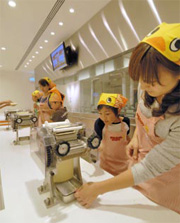Home > Highlighting JAPAN > Highlighting Japan NOVEMBER 2011 > Oodles of Instant Noodles
Highlighting JAPAN
COVER STORY: Variations on a Theme
Oodles of Instant Noodles
At the Cup Noodles Museum, which opened in Yokohama, Kanagawa Prefecture in September 2011, visitors can experience the "Creative Thinking" of Momofuku Ando, the inventor of instant ramen. When Ando died in 2007, age 96, the New York Times published an editorial appreciation to Ando titled simply, "Mr. Noodle." Shigeo Suemura interviewed the new Museum's director, Yukitaka Tsutsui.

Visitors to the Cup Noodles Museum can make their own Chicken Ramen. (Reservations must be made in advance.)
Credit: YOSHIFUSA HASHIZUME
Tell us about the concept for the Cup Noodles Museum and some of its highlights.
Yukitaka Tsutsui: The Cup Noodles Museum is an experiential museum where children's creativity and curiosity can be richly cultivated. You can experience the creative thinking of Momofuku Ando, the inventor of instant ramen, through various enjoyable exhibits. For example, inside the athletic facility made to look like a Cup Noodle factory, you yourself experience processes from the manufacturing of the noodles to their shipment. There is also a place where you can make your own Chicken Ramen.
Why did Momofuku Ando believe that instant ramen was needed?
Immediately after the end of World War II, malnutrition was widespread due to the difficulty of obtaining food, and many people died of malnutrition. One day he saw a long line of people waiting outside a ramen stall and thought, "It would make people happy if I could invent ramen that anyone could make easily."
Ten years later, after his business failed, Ando built a small shack for experimenting in the backyard of his home, and immersed himself in doing research about ramen alone. While acquiring the necessary equipment and ingredients, he experienced many failures, but in 1958 he perfected the world's first instant ramen, Chicken Ramen. It was the birth of a groundbreaking food that only required you to put the Chicken Ramen into a donburi (earthenware bowl), pour hot water over it, cover it and wait three minutes.
He made it all by himself?
In the case of noodles, he experimented with the ratios of water and salt and settled on them himself, and then once everything was almost complete, he had specialists put the finishing touches to them. This was Ando's development style. He would plan out almost all the manufacturing process himself, and then once it had taken shape, he would instruct different specialists in what to do.
The invention of the Cup Noodle (1971), where you just pour hot water into a cup and wait three minutes, was achieved the same way. The technology for drying the ingredients, the materials and shape for the cup and lid, even the plastic wrapping... all these were rare at that time. You could say that Ando invented everything including the manufacturing processes.
What was the inspiration for the Cup Noodle idea?
In 1966, when Ando traveled to Europe and the United States hoping to spread the word about instant ramen, he realized an obstacle would be that people in these countries did not eat from a donburi or use chopsticks. But when he saw Americans breaking Chicken Ramen in half and putting it into a paper cup, he realized, "This is it!" If the noodles are already in a cup, then you don't need a donburi.
The source of his creative power, where even usually overlooked things lead to ideas, was the same as the naturally strong inquisitiveness that children have. He was also very tenacious, never giving up even after numerous failures, until his idea became a reality.
Tell us about Ando's final invention, astro noodles.
When Momofuku Ando developed astro noodles, Space Ram, he was already over ninety years old. They are prepared just like cup noodles, by pouring hot water over them, but since the soup would fly around because there is no gravity, the soup was made from high viscosity gelatin.
Ando was overjoyed to see the astronaut Soichi Noguchi eating Space Ram aboard the Space Shuttle in 2005.
The picture of ramen being eaten in space probably symbolizes the creative thinking of Ando.
Meat Feast At the Tonpei store in Meatrea, customers can eat the celebrated local food of the people of Obihiro in Hokkaido, butadon (pork bowl). Credit: COURTESY OF KEIO CORPORATION Tokyo Meatrea offers takeout in all of its stores, allowing visitors to pick the items they want and try everything out at the food court-style tables. Visitors love this idea, and people of all ages can be seen walking around tasting the different meat offerings. Besides all the tastes and odors, the theme park offers creative ways to allow visitors to see, learn about, and enjoy meat recipes. Each store is designed to offer an excellent view of the kitchen, which offers the quite thrilling experience of appreciating the graceful skills of expert chefs as you savor their work. You will also enjoy learning tidbits about meat recipes in the adjacent museum. |
© 2009 Cabinet Office, Government of Japan






